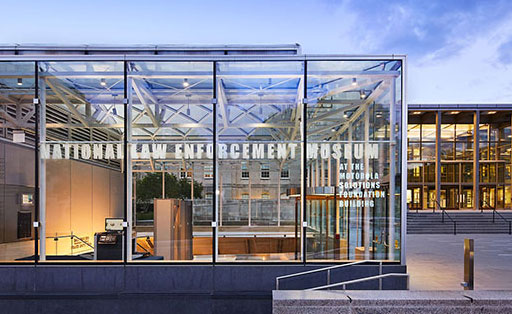
The National Law Enforcement Museum in Washington, D.C. offers citizens and law enforcement professionals a place to share in the vibrant story of American law enforcement.
The museum, which opened in October 2018, is located in Judiciary Square, across from the National Law Enforcement Officers Memorial, and just blocks from the National Mall and numerous DC landmarks.
It tells the story of American law enforcement by providing visitors with a ?walk in the shoes? experience. It is dedicated to expanding and enriching the relationship shared by law enforcement and the community through educational journeys, immersive exhibitions and insightful programs and community partnerships. It houses more than 21,000 objects from every era of law enforcement in multiple exhibits.
Some of the unique exhibits include ?911 Emergency Ops,? where visitors take on the role of a 911 operator, hearing scripted 911 calls and dispatching first responders to assist; and ?Take the Case?, which invites visitors to use actual law enforcement techniques to collect and analyze evidence, interview suspects, and solve simulated crimes.
An exhibition called ?To Serve and Protect? describes a specific event from the perspectives of law enforcement officers, victims, and bystanders. Real-life events, such as the law enforcement response to the 9/11 terrorist attacks, help tell the stories of officers who relied on training, instinct, and courage to protect citizens.
Museum?s Unique Construction and Design
The design and construction of the museum is uniquely modern. First, the 55,000 square foot museum is mostly located underground. The museum?s is only visible via two, all-glass pavilions that mark its presence on the street.
While the museum?s exterior is contemporary, with an all-glass facade that allows for ample light, the exterior fits in with the architecture of the other buildings in the area. ?We had to go through a very strict design process with the architects and with the District of Columbia, the Commission of Fine Arts, and the Washington D.C. Historical Preservation Office,? says Paul Larson, Sr. Director of Security and Museum Operations for the museum.
The museum’s top floor, the only one above ground, houses the two pavilions that are open to the public. The next floor down holds the cafe and the museum store, while the exhibits are on the lowest level. Buckley & Associates Inc. designed the building and Clark Construction served as the general contractor. The museum received LEED Silver certification in February of 2019, and was the first LEED Silver certified museum in Washington, D.C.
Boom Edam?s All Glass Doors Complement the Museum?s Modern Design
The museum has quickly become a popular visitor attraction ? on average, 300 to 500 visitors tour it each day. ?During National Police Week and the weeks leading up to it, we average about 3,000 people a day,? Larson says.
?We have a candlelight vigil on one of the nights that is attended by tens of thousands of people on the National Mall, in addition to multiple celebrations during the week. During this peak time, we typically have 150 visitors enter the museum?s doors every 15 minutes.?
The two pavilions are the primary entrance and exit for visitors to the museum. The East Pavilion welcomes visitors and directs them to a security screening area and then downstairs to the Visitor Services area where they enter the exhibits area. Visitors exit from the West Pavilion. There are separate entrances for individuals with disabilities.
The museum needed two-door solutions that would allow for high traffic throughput on a daily basis, would fit into the design elements and would be energy efficient in both hot and cold weather.
The museum?s architect chose two Boon Edam BoonAssist TQ manual revolving doors with all glass door wings to achieve those goals. The doors are constructed primarily from glass with only a few stainless steel components to ensure structural strength.
Their design fits seamlessly with modern glass facades such as the museum?s pavillions, or in more traditional or classic building designs. A BoonAssist revolving door has a low-energy drive to assist users as they push the door wings, as well as speed control for safety and automatic positioning back to ?home? position when the door is not in use. The positioning feature maximizes the air seal to prevent unwanted air infiltration from the outdoors. Source: boonedam.us

